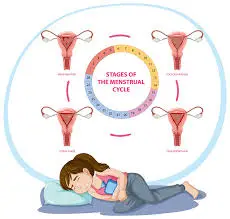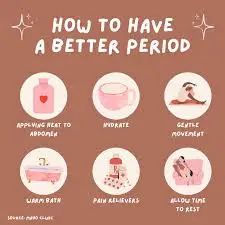Menstruation, commonly referred to as a “period,” is a natural biological process that occurs as part of the menstrual cycle in people with female reproductive systems. It involves the shedding of the lining of the uterus (endometrium) through the vagina when pregnancy does not occur. Here’s an overview of the menstrual cycle and menstruation:
Menstrual Cycle Phases:

1. Menstrual Phase (Days 1-5):
– The cycle starts with menstruation, where the uterine lining is shed.
– Bleeding typically lasts 3-7 days, but it can vary.
2. Follicular Phase (Days 1-14):
– Begins on the first day of menstruation and continues until ovulation.
– The pituitary gland releases follicle-stimulating hormone (FSH), stimulating the ovaries to produce follicles (one becomes dominant).
– The dominant follicle releases estrogen, leading to the thickening of the uterine lining.
3. Ovulation (Around Day 14):
– A surge in luteinizing hormone (LH) triggers the release of a mature egg from the ovary.
– The egg travels down the fallopian tube, where fertilization by sperm could occur.
4. Luteal Phase (Days 15-28):
– After ovulation, the ruptured follicle forms the corpus luteum, which secretes progesterone.
– Progesterone further prepares the uterine lining for a potential pregnancy.
– If the egg isn’t fertilized, the corpus luteum breaks down, leading to a drop in progesterone and estrogen, which triggers menstruation.
Common Symptoms During Menstruation:

– Physical: Cramps, bloating, breast tenderness, headaches, fatigue.
– Emotional: Mood swings, irritability, anxiety, or sadness.
Managing Menstrual Symptoms:

– Pain relief: Over-the-counter pain relievers like ibuprofen.
– Heat therapy: Applying a heating pad to the abdomen.
– Exercise: Light physical activity can alleviate cramps.
– Dietary changes: Reducing caffeine and salty foods can help.
When to Seek Medical Advice:
– If periods are extremely heavy, irregular, or painful, it could indicate conditions like polycystic ovary syndrome (PCOS), endometriosis, or fibroids.
0 Comments